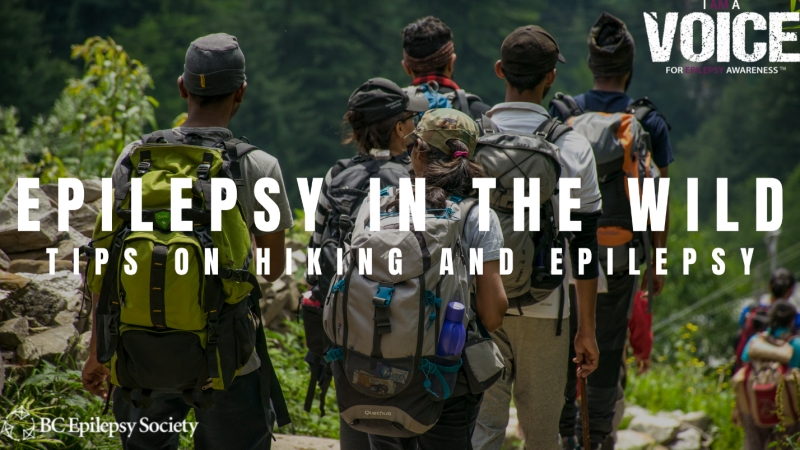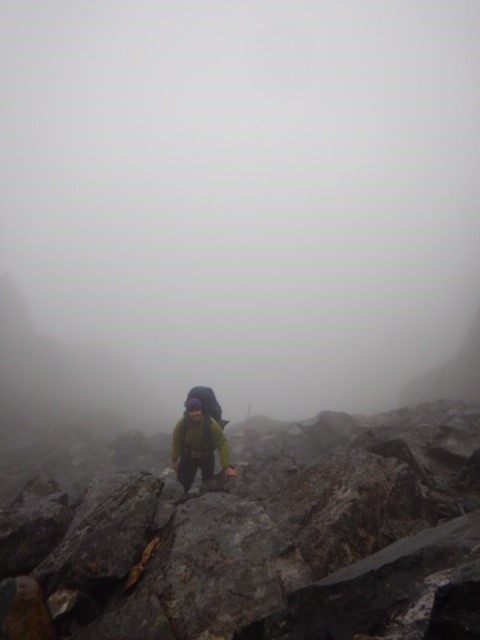Epilepsy in the Wild – Tips on Hiking and Epilepsy

Hey guys, this is Chris Winwood, the Epilepsy Outreach & Education Coordinator in Prince George. I wanted to talk with you guys today about hiking and epilepsy. Read on to find out my tales about hiking while living with epilepsy as well as check out our tips for those of you who may be considering doing some hiking.
In the summer of 2019, a friend and I went to the Yukon and hiked the Chilkoot Trail, one of the most historic and well-worn trails in North America. The trail starts in Alaska and ends in the Yukon and covers 53 km of varying terrain, starting in northern coastal rainforest making its way up to alpine tundra and finally into subalpine boreal forest. One of its pivotal points on this route is the climb on the “golden staircase”, which is the final stage of the climb that takes you up to the highest section of the Chilkoot pass, 1,067 m above sea level.

Me at the “golden staircase”
We got to this section of the trail under fogy damp conditions. About halfway up the stairs, I looked back at my friend and asked, “Hey, what would we do if I had a seizure right now?” She looked into the fog thinking for a moment and then looked back at me and said, “Easy, you’d have the seizure, I’d treat any major traumas, we’d find a stable spot to wait until you recovered and then continue going up.” I smiled and nodded in agreement. It really was that simple.
It was an empowering moment. Before I was diagnosed with epilepsy, I did hikes like this all the time and after I was diagnosed with epilepsy, I still did them. Walking in high alpine tundra, dense west coast rainforest, spending nights in a tent with the sounds of the forest at night … that was where I came alive. These are the things that made me happy before and they still make me happy now. Although adjusted what we would do and how we would do it, my epilepsy did not stop us from doing it.
My friend and I are both experienced backcountry hikers and have both dealt with injuries in the field before. We had planned this trip with epilepsy in mind, but it had not been a big factor. We knew the trail was clearly marked and well-used. We knew the distances we had to go each day. We were both fit and had a lot of experience in the backcountry between us.
One thing was for sure we were not going to let epilepsy stop us from enjoying this backcountry trip. Epilepsy quickly dropped into the background with each step that I took on the trail simply letting nature come in and wash those worries to the back of my mind.
If you have epilepsy, you may have been told that going on a hike is too risky because of the potential of having a seizure while on the hike. Having a seizure on a hike is no different than getting hit in the head by a rock on a hike as they both may have serious implications. If the possibility of getting hit on the head by a rock during a hike wouldn’t stop me from hiking, then why should the possibility that I would have a seizure?
The important thing to do is to take precautions. When hiking in areas where getting hit on the head by a rock is a potential hazard, hikers will take certain precautions like not hiking under someone above you. It’s the same with epilepsy. Some examples of precautions on a hike because of epilepsy would be to avoid a certain area because of the terrain around it or being more cautious around river crossings. Epilepsy does not stop me from hiking, it just modifies how I do it.
If you have epilepsy and are considering going on a hike of some sort, please read on for some of our tips:
- Tip One: Talk to Your Neurologist: No one knows what your limitations are due to your epilepsy or your seizures better than your neurologist. Before planning on going on a hike, first consult with your neurologist to see if you are able to go on a hike with your epilepsy and to see if there are any considerations that they can help you with.
- Tip Two: Have a Hiking Partner: Never go hiking alone as this is dangerous for all people and is even riskier for people living with epilepsy. Employ the buddy system and get a hiking partner or go hiking in a group.
- Tip Three: Ensure You Have Enough Medication: Make sure you have enough of your medication for the time you will be hiking and a little bit extra in case you need it. On this hike, I carried two weeks of my medication in my backpack and my hiking partner carried another two weeks of my medication in her backpack.
- Tip Four: Remember to Take Your Medication: It is important not to miss a dose of your medication as missed medication is one of the main triggers for seizures.
- Tip Five: Teach Seizure First Aid to Your Hiking Partner: It is important to ensure that your hiking partner is aware that you have epilepsy and knows how to assist you if you have a seizure. Check out information on seizure first aid here.
- Tip Six: Know Your Triggers: Seizures can be triggered by a number of factors, including flashing lights (if you have photosensitive epilepsy), the use of alcohol and drugs, lack of sleep and other triggers. It is important that you are aware of any triggers you have and trying your hardest to avoid them while hiking. Find out more about seizure triggers here.
- Tip Seven: Listen to Your Body: It is important to listen to your body and pay attention to any signs that you may have a seizure. It is also important not to push yourself and rest when you need to.
- Tip Eight: Wear Medical Identification: Wearing medical identification helps make others around you aware that you have epilepsy so that they are informed. You can also create a wallet card that explains that you have epilepsy, what to do if you have a seizure and has other pertinent information, such as emergency contacts, medication list, etc.
- Tip Nine: Get an Emergency Contact Device: This is something that is helpful for anyone going on a longer hike, especially where there may not be cell service. On this hike, me and my hiking partner made use of an emergency beacon device called a Spot which allowed us to send three different types of messages: (1) we are safe at this location; (2) we need help; and (3) an SOS call. This device allowed us to check in with our friends and family so they knew that we were safe or that they could call for help if we needed it.
- Tip Ten: Take a First Aid Kit: A first aid kit is helpful for anyone going on a hike so that they can treat any minor or major injuries incurred on the hike, whether or not they are due to epilepsy or a seizure. It is important that either you or your hiking partner have the knowledge of how to use a first aid kit.
Epilepsy can often make us feel like the world beyond the front door is forever shut that the world has been forever shrunk. I do not believe this is the case. Getting outside was one of the biggest ways I got over my diagnosis. It’s a fantastic way to get exercise and greatly improves my mental health.
Epilepsy does have an impact on what we do because we do have to adjust and think about how to do things differently. However, that does not mean that we should stop doing things. You should do what you can do and what you are comfortable with doing. If that means going for a short walk around your local park with a friend, do it. If that means going for a longer hike with a friend, do it.
Epilepsy can impact our lives so much and make us feel powerless but going outside with our friends and family is one of the best ways to empower ourselves to take our lives back. The outside is not out of reach, we just must adjust how we get there.
Stay Safe Everyone!
-Chris Winwood





